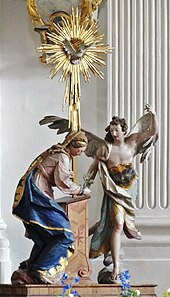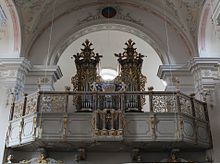St. Peter and Paul (Weyarn)
The Catholic parish church of St. Peter and Paul is a listed church building in Weyarn , a municipality in the Miesbach district ( Bavaria ). It was originally the collegiate church of the former Augustinian canons of Weyarn . The parish belongs to the Miesbach deanery in the Archdiocese of Munich and Freising .
history
From the year 1133, the founding year of the monastery, the following text is handed down in the foundation charter of Sigebotho that he gave to the foundation of a monastery with his own official for viticulture in honor of the princes of the apostles Peter and Paul ... Archbishop Konrad I of Salzburg was the first recipient of the foundation. The cathedral chapter had the right to lead elections in provost elections as well as the right of presentation .
The three-aisled basilica was added to the castle and the modified castle became a monastery. The church and monastery burned down in 1356. Under Provost Heinrich II, the church was rebuilt with three naves in Gothic style, and the Magdalen and Nikolaus chapel were added to the choir . The new church was consecrated on June 24th, 1374. Count Georg von Waldeck had a burial place laid for himself in the Georgskapelle in the 14th century. The erection of the tower in the 15th century made it necessary to relocate the burial place of the donor family in front of the steps of the chancel.
Weyarn was also affected by the general decline of the monasteries in the 16th century; this situation changed at the beginning of the 17th century, during the tenure of provost Wolfgang Reiffenstuel (1607–1627). Provost Valentin Steyrer followed him until 1659. After that, the duke appointed two administrators. The monastery property grew. In 1677 the seminary, library and church fell victim to a fire.
Gelasius Harlaß had today's church built from 1687 to 1693 on the site of the previous church. The Pope gave him the right to wear the inful at solemn church services . The builder was Lorenzo Sciasa from Graubünden, and the church was consecrated on August 9, 1693 by Auxiliary Bishop J. Sigmund Zeller. After being damaged in 1706 and 1713 during the War of the Spanish Succession, the monastery recovered quickly. The Bavarian Rococo sculptor Ignaz Hamel created the interior of the church in the middle of the 18th century. At that time only the high altar stood in the church, the eight side altars were added between 1695 and 1700.
Rupert Sigl was the last provost from 1765 to 1803. Weyarn Monastery was dissolved on March 19, 1803. According to §§ 35 and 42 of the Reichsdeputationshauptschluss , the inventory was auctioned, the proceeds amounted to 7,887 florins. During the extensive renovation of the interior from 1974 to 1980, the stucco was restored to its original color as far as possible. The paintings and frescoes were also cleaned during this time. A convent of the German Brethren Province of the Teutonic Order has existed in Weyarn Abbey since 1998 . In the same year the monastery became the headquarters of the order province (also called the priory) and the Teutonic Order.
tower
The lower part of the 15th century tower in the corner of the choir has been preserved. At the beginning of the 17th century a new church tower was built. In 1713 it was raised with a two-storey octagon, and a dome was chosen to finish off.
Furnishing
The carved figures by Ignaz Günther ( Annunciation , Pietà , Immaculata ) are particularly famous . They were carved as carrying groups for processions, partly on behalf of the local Rosary Brotherhood, in the years 1755 to 1765 and painted in color by Nikolaus Nepaur. The interior of the church also impresses with its magnificent stucco work and frescoes , which Johann Baptist Zimmermann created in 1729.
organ
The organ front from 1745 was retained during the renovation in 1913. At the request of the Bavarian State Office for Monument Preservation, the pneumatic organ was replaced by a mechanical one. The new organ was built according to old documents by the organ building company Anton Staller from Grafing. The number of registers has been increased by five to a total of 22. The year 1829 can be seen above the organ, which indicates a major renovation.
literature
- Weyarn Collegiate Church (= Little Art Guide No. 612). Verlag Schnell and Steiner, Munich & Zurich, fourth edition 1962
- Florian Sepp: Weyarn. An Augustinian canon monastery between Catholic reform and secularization , Munich 2003 ( Studies on the Old Bavarian Church History. , Volume 11)
- Jan H. Marbach: The Augustinian Canons on the Mangfall. A history of the Weyarn monastery and its area of influence. Self-published by the community of Weyarn, Weyarn 2002, ISBN 3-937425-00-4 .
Web links
Individual evidence
- ↑ Emmeram Oberberger: Stiftskirche Weyarn (Schnell Art Guide, No. 612, first edition 1955), 11th edition 2016.
Coordinates: 47 ° 51 '27.1 " N , 11 ° 47' 47.8" E









